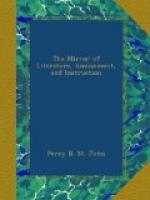Title: The Mirror of Literature, Amusement, and Instruction Volume 13, No. 363, Saturday, March 28, 1829
Author: Various
Release Date: February 27, 2004 [EBook #11331]
Language: English
Character set encoding: ASCII
*** Start of this project gutenberg EBOOK mirror of literature, no. 363 ***
Produced by Jonathan Ingram, Elaine Walker and the
Online Distributed
Proofreading Team.
THE MIRROR OF LITERATURE, AMUSEMENT, AND INSTRUCTION
Vol. XIII, No. 363.] Saturday, march 28, 1829. [Price 2d.
GUY’S CLIFF.
“A home of pleasure, a place meet for the Muses.”—Leland.
Warwick—what olden glories and tales of other times are associated with this county. How many of its sites are connected with high-minded men and great and glorious actions. To the antiquary, the poet, and the philosopher, every foot is hallowed ground; and even the cold calculations of the commercial speculator treat with regard a county whose manufactures add to the stock of national wealth and importance. How many stories of love, war, and chivalry are told of its halls, castles, and monasteries, their lords and ladies and maidens of high birth. Kenilworth and Stratford—Leicester, SHAKSPEARE and Warwick—like long trails of light, all flit before us in this retrospective dream of the days of “merry England.”
Guy’s Cliff is situated about one mile and a half north-east of Warwick. Here the river Avon winds through fertile meadows; and on its western bank, a combination of rock and wood, singularly picturesque, invited at an early period the reveries of superstitious seclusion and poetical fancy. It is supposed that here was an oratory, and a cell for the hermit, in Saxon times; and it is certain that a hermit dwelt in this lovely recess in the reigns of Edward III. and Henry iv. This is the spot to which the renowned Guy, Earl of Warwick, is said to have retired after his duel with the Danish Colbrond;[1] and here his neglected countess, the fair Felicia, is reported to have interred his remains. It appears that Henry V. visited Guy’s Cliff, and was so charmed with its natural beauties, and, probably, so much interested by the wild legend connected with the place, that he determined to found a chantry for two priests here. But war and an early death prevented the performance of this, among many other pious and benevolent intentions ascribed to the heroic Henry. Such a chantry was, however, founded in the first year of Henry VI. by Richard Beauchamp, Earl of Warwick; but the chapel and some contiguous buildings were not completed till after the earl’s decease. In this delightful retreat lived John Rous, the antiquary, as a chantry priest.




